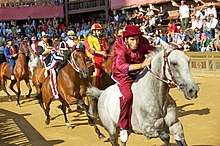Sport in Italy
Sport in Italy has a long tradition. In several sports, both individual and team, Italy has good representation and many successes. Football is the most popular sport in Italy. Italy won the 2006 FIFA World Cup, and is (along with Germany) currently the second most successful football team in World Cup history, after Brazil, having won four FIFA World Cup championships.
| Part of a series on the |
| Culture of Italy |
|---|
 |
| History |
| People |
| Languages |
| Traditions |
| Cuisine |
| Festivals |
| Religion |
| Art |
| Literature |
|
Music and performing arts |
|
Media |
| Sport |
|
Monuments |
|
Basketball, volleyball, and cycling are the next most popular/played sports, with Italy having a rich tradition in all three. Italy also has strong traditions in swimming, water polo, rugby union, tennis, athletics, fencing and Formula One.
Participation by sport
This list, published by Italian National Olympic Committee, refers to a survey made by National Institute of Statistics (Italy) in 2000.[1]
| # | Sport | Participants | National teams | Details |
|---|---|---|---|---|
| 1 | Football (including futsal) | 4,363,000 | Football Futsal | Football in Italy |
| 2 | Aquatic (water) sports | 3,480,000 | Swimming Diving Water polo | |
| 3 | Gymnastics (including physical education) | 2,204,000 | ||
| 4 | Skiing | 2,060,000 | ||
| 5 | Cycling | 1,321,000 | Cycling | |
| 6 | Tennis | 1,298,000 | Davis Cup team Fed Cup team | Tennis in Italy |
| 7 | Volleyball (including beach volleyball) | 999,000 | Volleyball (men) | |
| 8 | Athletics (including road running) | 995,000 | Athletics | Athletics in Italy |
| 9 | Basketball | 606,000 | Basketball | |
| 10 | Bodybuilding (including physical fitness) | 555,000 |
Popular sports
Football
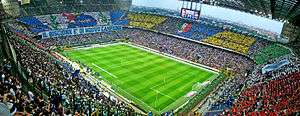
Football is the most popular sport in Italy.[2] The Italian national football team has won the FIFA World Cup four times (1934, 1938, 1982, and 2006), trailing only Brazil (with 5) and level with Germany (with 4). Serie A clubs have seen success in the Champions League (formerly the European Cup), the premier European club competition, winning it twelve times. The Italian word for soccer is calcio, "kick", taken from the name of Italy's traditional football games, as opposed to being adapted from the English name football or soccer, as in most other languages. Often, Italian children can be seen playing on the street with friends and relatives.
The history of football in Italy gives much of the explanation behind why it has remained such a popular sport today. The first record of an Italian football team goes back to 1893. This team was named FC Genoa. The sport was brought to Italy through the Romans, who used to play a very similar game called harpastum, which included two teams aiming to score on their opponents side (hands could be used along with feet). Years later, the Renaissance brought about big changes for not only the art and culture of Italy, but also for sport. Specifically, Florence was the spot where the most changes occurred. Football of the past was different then it is today because teams were much larger with 27 people. Also, the games were only 50 minutes long. Today, the games consist of two 45 minute halves. The Italian National team first began playing in 1910 in the FIFA World Cup.[3] To the surprise of many fans, the Italian National Team did not qualify for the tournament in 2017. This was the first time in sixty years that the team did not make the World Cup after losing to Sweden. The loss was published in popular sport newspapers in Italy such as La Gazzetta Dello Sport, which is one of the largest selling newspapers in Italy.[4]
Stadiums have also become more than a place to watch a football game today. All across Italy, stadiums now include various different things such as museums, shops, and restaurants for the people attending the game to enjoy. Italian football stadiums also host other venues such as concerts, rugby matches, and field and track.[5] Italy takes pride in their football stadiums and have some of the most well-known in the world. Most Italian stadiums have stadium tours where children six and under are allowed to go for free . The Milan and Internazionale (more commonly known as Inter Milan) stadium, which is also known as the San Siro stadium, has the biggest seating capacity in Italy with 80,018 seats.[6] The stadium has the worldwide nickname of “La Scala del Calcio.” It is also known as the "Giuseppe Meazza" stadium after the Italian star, Giuseppe Meazza[5]. The San Siro stadium has hosted four UEFA Champions League finals. Another famous stadium in Italy is the Stadio Olimpico. This stadium is the second largest in Italy and is where the rival teams AS Roma and SS Lazio play. The two clubs meet twice a year and the matches between these two clubs are known as the Derby della Capitale (Derby of the Capital). Also, the Stadio Olimpico holds the Coppa Italia Final[6].
Being a football country, Italy has some all time great players that have played for them. Fabio Cannavaro played professional football from 1992 to 2011. He is among only one of three defenders to have been named FIFA's Player of the Year. Cannavaro won the award in 2006 which is the same year he also helped Italy reach the finals of the World Cup. Another one of Italy’s all time great football players was Dino Zoff. Zoff played goalie for Italy, and at 40 years old he became the oldest player to win the World Cup. Also, Dino holds the record for the longest time without giving up a goal at an international tournament with 1,142 minutes. His club play includes six Serie A titles. After retiring from playing football, Dino later became a coach. Another great Italian football player was Giuseppe Meazza. Meazza scored 33 goals in his 53 World Cup appearances. Meazza has the second most goals scored for Italy all time since he is only two goals behind Luigi Riva. Giuseppe won two World Cup’s with Italy as well as winning three Serie A titles and one Coppa Italia title.[7]
Athletics
Athletics is a popular sport in Italy, because Italian World or Olympic champions are very celebrated people. There are many national and international events every year. Amonngst the most famous Italian athletes, there's the sprinter Pietro Mennea (1952-2013) who held the 200 metres world record (19:72) for 17 years from 1979 to 1996 and is still holder of the European record.
Aquatic (water) sports

Among the more popular are:
- Swimming
- Synchronized swimming
- Diving
- Free-diving
- Sailing
- Boat racing
- Rowing
- Water skiing
- Surfing
- Water basketball
- Water polo
Cycling
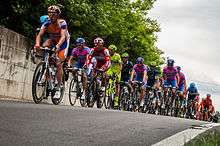
Cycling is a well-represented sport in Italy. Italians have won the World Cycling Championship more than any other country, except Belgium. The Giro d'Italia is a world-famous long-distance cycling race held every May, and constitutes one of the three Grand Tours, along with the Tour de France and the Vuelta a España, each of which last approximately three weeks.
Two of the five 'Monuments', the oldest and most prestigious one-day races on the cycling calendar, are located in Italy: Milan–San Remo, held in March, and Giro di Lombardia, held in September or October.
Some of the most successful Italian road cyclists have been Costante Girardengo, Fausto Coppi, Gino Bartali, Alfredo Binda, Felice Gimondi, Fiorenzo Magni, Mario Cipollini, Francesco Moser, Marco Pantani, Moreno Argentin, Paolo Bettini, Michele Bartoli, Gianni Bugno, Alessandro Petacchi and Vincenzo Nibali.
Basketball
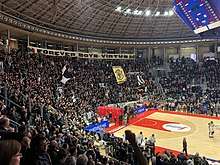
Italy is one of the main basketball nations in Europe, along with Spain, Serbia, Greece, Slovenia, Lithuania, Croatia, Russia, Turkey, and France. It has a long and rich tradition in the sport. The Italian national basketball team's best results were gold at Eurobasket 1983 and EuroBasket 1999, as well as silver at the Olympics in 1980 and 2004.
Until the 2000s, the Italian League was considered the strongest domestic league outside of North America. It has recently been overtaken by the Spanish ACB, but is still one of the top leagues in Europe, along with the VTB United League in Russia with teams in other nearby nations, the Greek Basket League, the Adriatic League, and the Baltic League. Its clubs have won the most EuroLeague championships (13), the most FIBA Saporta Cups (15), and the most FIBA Korać Cups (10).
Famous Italian club teams include Olimpia Milano, Virtus Bologna, Pallacanestro Varese, Pallacanestro Cantù, Fortitudo Bologna, Victoria Libertas, Pallacanestro Treviso, Mens Sana 1871, Virtus Roma, Pallacanestro Trieste, JuveCaserta and Scaligera Verona.
Rugby union
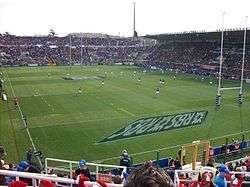
Rugby union enjoys a good level of popularity, especially in the north of the country. From the 2010–11 season, Italy has had two teams in the Pro12, previously an all-Celtic competition, involving teams from Ireland, Scotland, and Wales. To accommodate this move, the country's National Championship of Excellence effectively became a semi-professional developmental competition. The two Pro12 sides took up Italy's existing places in the elite Europe-wide club competition, then known as the Heineken Cup and now as the European Rugby Champions Cup, and four Eccellenza sides compete in the second-tier European Rugby Challenge Cup. Italy's national team competes since 2000 in the Six Nations Championship, and is a regular at the Rugby World Cup, despite having yet to pass the group stage. Italy are classed as a tier-one nation by World Rugby.
Rugby union in Italy goes back around a century, and it has been established that British communities brought rugby to Genoa, between 1890 and 1895, with other confirmations of games in Italy around 1909. The society that organised the first games did not survive long and dissolved soon after them.
Rugby union's traditional heartland consisted of the small country towns in the Po Valley, and other parts of Northern Italy.[8] One version says that Italian workers returning from France, particularly the south, introduced the game there, and gave it a significant rural/working class base, which still exists in towns such as Treviso and Rovigo.[8] A demonstration game was also played in 1910, in Turin between Racing Club Paris and Servette of Geneva. French students also introduced the game to Milan University c. 1911. While each of these events has been hailed as the "origin of Italian rugby", it seems that they probably happened more or less simultaneously and independent of one another, and that the introduction of rugby to Italy was a series of events, rather than a single starting point. Whatever the ultimate origins of the game in northern Italy, the region's proximity to the French rugby heartland helped as well.
Skiing
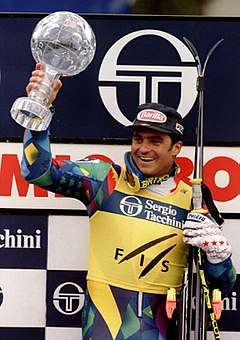
- Alpine skiing or ski (sci) is a very popular sport in Italy, with more than 2,000,000 skiers, most of them in the northern regions near the Alps and in the central provinces near the Apennine Mountains. Italian skiers have achieved good results in the Winter Olympic Games, World Cup, and World Championship, most notably Zeno Colò, Gustavo Thoeni, who won 4 Overall World Cups between 1970 and 1975; Piero Gros, who was Overall World Cup champion in 1974, and Alberto Tomba who won the Overall World Cup in 1995. Tomba, Deborah Compagnoni, and Isolde Kostner received many medals in different editions of the Winter Olympic Games. Giorgio Rocca and Manfred Mölgg won the Slalom World Cup in 2006 and 2008 respectively, whilst Giuliano Razzoli was Olympic slalom champion in 2010.
- Cross-country skiing is popular in northern Italy, with the likes of Stefania Belmondo, Manuela Di Centa, Franco Nones, Marco Albarello, Silvio Fauner, Giorgio Vanzetta, Giorgio Di Centa and Federico Pellegrino.
Tennis
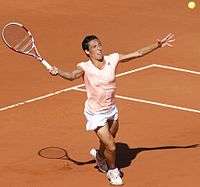
Tennis has a significant following near courts and by television. Italian professional tennis players are always in the top 100 world's ranking of male and female players. Beach tennis with paddle racquet was invented by Italians, and is practiced by many people across the country. Italy won the Davis Cup in 1976 and the Fed Cup in 2006, 2009, 2010 and 2013. Italian players such as Sara Errani, Flavia Pennetta, Roberta Vinci and Francesca Schiavone have entered the WTA Top 10 in their careers. Schiavone was the first Italian player to win a Grand Slam singles title, winning the 2010 French Open; she was later followed by Pennetta, who won the 2015 US Open. The doubles duo of Sara Errani and Roberta Vinci have accomplished a Career Grand Slam in doubles, have been named ITF World Champions 3 years in a row (2012, 2013, 2014) and have ended every season since 2012 as World No. 1. The Italian Open, held since 1930, is one of the oldest and most respected clay tournaments in the world after the French Open.
Volleyball
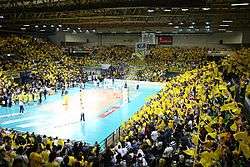
Volleyball (pallavolo) is played by a lot of amateur players.
The Italian Volleyball League and Italian Women's Volleyball League are held since 1946. Modena Volley won 12 neb's titles, Volley Treviso nine, and Parma eight. Teodora Pallavolo Ravenna won 11 women's titles, Bergamo eight, and Audax Modena five.
In the CEV Champions League, Modena and Treviso won four titles each, Porto Ravenna and Trentino Volley three, Parma two, and CUS Torino and Volley Lube one. In the CEV Women's Champions League, Bergamo won seven titles, Olimpia Teodora Ravenna Sirio Perugia and Matera two each, and Modena and Casalmaggiore won one each.
The Italy men's national volleyball team won the FIVB Volleyball Men's World Championship three times, the FIVB World League eight times, and the Men's European Volleyball Championship six times.
The Italy women's national volleyball team won the FIVB Volleyball Women's World Championship once, and the Women's European Volleyball Championship once.
Winter sports
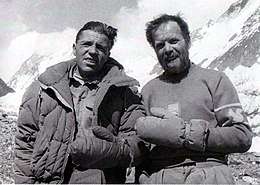
Winter sports or sport invernali in Italian language, are popular in Italy. Among them, Italians excel in cross-country skiing (sci di fondo), but also in luge (slittino), with the two time Olympic gold medal winner Armin Zoeggeler.
- Alpinism (alpinismo) is followed, because Italian alpinists wrote several pages of history in this sport. Italians Achille Compagnoni and Lino Lacedelli conquered first the summit of K2 (8611 m) in 1954, in the expedition led by the geologist Ardito Desio. Reinhold Messner was the first man in the world to reach the 14 summits, over 8,000 meters, and the first one to climb Mount Everest alone and without oxygen. Cesare Maestri conquered the Cerro Torre in Patagonia in 1959. Walter Bonatti is considered one of the best alpinists in Europe in 1950s, realizing some ascents considered impossible by the competitors.
- Ice hockey is played by professional players in Serie A (hockey) with substantial attendance.
- Figure skating is a popular sport and professional figure skaters often starring in events of exhibition.
- Bobsleigh is very followed, because Italian bobsledder Eugenio Monti was the most successful athlete in the international history of this sport.
- Luge is followed from its history, with Paul Hildgartner and Gerda Weissensteiner to the recent dominance of Armin Zöggeler.
- Alpine skiing has delivered considerable success for Italian competitors over the years – Italian skiers who have won multiple global titles include Zeno Colò, Gustav Thöni, Piero Gros, Alberto Tomba, Deborah Compagnoni and Isolde Kostner.
- Cross-country skiing is a sport where Italians have enjoyed success in recent decades: among the most notable Italian competitors in this sport are Stefania Belmondo, Gabriella Paruzzi, Pietro Piller Cottrer and Giorgio Di Centa.
Bodybuilding
In Italy, bodybuilding is at the 10th place in the ranking of most popular sports, even considering the high number of people who engage in body building gym, as amateur, just to keep fit themselves.
Combat sports
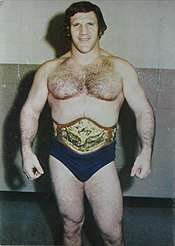
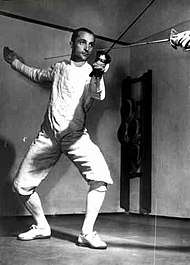
Combat sports are participated and followed sports. There are many national and international events every year. Fencing is a very successful sport and Italy is the most successful fencing country at the Olympics.
- Fencing, a successful sport for the Italy national fencing team.
- Boxing
- Kickboxing
- Martial arts
- Mixed martial arts
- Amateur wrestling
Equestrian sports
Olympic disciplines, horse racing, equestrian vaulting, and polo are participated and followed sports. There are many national and international events every year.
Baseball
Baseball sees less activity in Italy than most other sports. Introduced to Italy by American servicemen during World War II, professional baseball leagues were not established until after the war. The Italy national baseball team is traditionally ranked as the second best team in Europe, behind the Dutch national team.[9] Italy's performance during the Olympics has been consistently high for a European team, but is noted for its reliance on American and Latino players of Italian descent. The highest level of play in Italy today is considered to be on par with Class A ball in the United States.[10]
Cricket
The Italian national cricket team is the team that represents the country of Italy in international cricket matches. They have been an associate member of the International Cricket Council since 1995, having previously been an affiliate member since 1984. The team is administered by the Federazione Cricket Italiana (Italian Cricket Federation). They are currently ranked 25th in the world by the ICC, and are ranked fifth amongst European non-Test teams. The Italian national cricket team has won several European Cricket tournaments, and the popularity of cricket is rising. All the Italian cricketers are home grown cricketers, and they had a well off position in the recent European Indoor Cricket Tournament and the European Cricket Championship. They recently participated in the ICC World Cricket League Division 4.
Motorsports
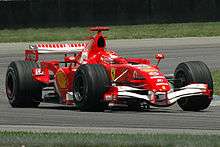
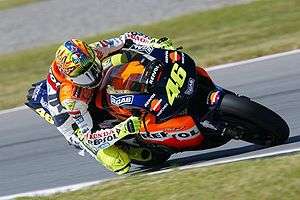
Italians have a great passion for their motorsport, and their Formula One team Ferrari has had great success over the many years as they have competed in the sport since 1950, when the sport first started. They have won 16 constructors' championships and 15 drivers' championships. This team is also the most successful engine manufacturer in the sport, and this shows in their performance in their F1 team and cars. Their World Champions are Alberto Ascari, Juan Manuel Fangio, Mike Hawthorn, Phil Hill, John Surtees, Niki Lauda, Jody Scheckter, Michael Schumacher and Kimi Räikkönen.
Giacomo Agostini (born 1942) is the holder of the record of 122 motorcycle Grand Prix wins and 15 World championship titles in two classes: 8 in the 500cc, the other 7 in the 350cc. Valentino Rossi (born 1979) has won 89 Grands Prix and 9 World Championships, but he's the only motorcycle racer to have won their world titles in 4 classes: one each in the 125cc, 250cc and 500cc, and six in the MotoGP.
Golf
Golf is played by over 9,000 registered players as of 2007. There are several male and female professional players, with notable current players including Costantino Rocca, the brothers Edoardo, and Francesco Molinari, and Matteo Manassero. The most important tournament is the Italian Open. The Molinari brothers won the World Cup of Golf in 2009.
Gymnastics
Gymnastics is a popular sport in Italy. At the turn of the millennium, Italy showed a growing quality in the discipline, with Susanna Marchesi finishing 9th at the Individual All Around competition, as well as the team winning 6th place in the 2000 Summer Olympics. The Italian team won the silver medal at the 2004 Summer Olympics and came in at 4th place at the 2008 Summer Olympics. They also collected a string of medals throughout the 2005–2008 Olympic cycle. At the 2009 Rhythmic Gymnastics Championship in Mie, Japan, the team soared to first place, winning the gold medal and becoming the new queens, a feat they achieved again at the 2010 Rhythmic Gymnastics Championship in Moscow. The celebration of the Italian team is because they're among the best squads in the world, facing competitions against the Eastern European block of nations: Belarus, Russia, and Bulgaria.
Rugby league
Rugby league was established prior to the 1950s, and the Italian national rugby league team plays in various international competitions.
Traditional sports
Several traditional team ball sports, called sferistici in Italian language, are played in sphaeristerium, or sferisterio in Italian language, so also in open playing fields since 1555 and when Antonio Scaino from Salò regulated pallone col bracciale. There are many modalities of these sports: pallone col bracciale, pallapugno, pallapugno leggera, palla elastica, palla, and tamburello. Professional players compete in the national circuit of tournaments and international championships.
- The traditional sport of bocce is a popular sport and pastime.
- Cue sports are played on traditional billiard table in many forms: five-pins, goriziana (nine pins), and boccette. There are almost 6,000,000 amateur players and professional players who compete in national circuit of tournaments and international championships.
- Palio or annual athletic contest is followed very much, because every comune celebrates ancient events in these competitions. The most famous in the world is palio di siena.
Italy at the Olympics
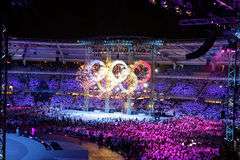
Italy has competed at most of the modern Olympic Games, missing only the 1944 Winter Olympics, because of World War II.
Italy has hosted the Games on four occasions:
- 1956 Winter Olympics in Cortina d'Ampezzo.
- 1960 Summer Olympics in Rome.
- 2006 Winter Olympics in Turin.
- 2026 Winter Olympics in Milan and Cortina d'Ampezzo.
Italian athletes have won 549 medals at the Summer Olympic Games, and another 114 medals at the Winter Olympic Games. Italy has won a total of 663 medals, which makes them the sixth most successful country in Olympic history. The Italian National Olympic Committee was created in 1908 and recognized in 1913.
In the Summer Olympic Games, Italy has finished 2nd in 1932, 3rd in 1960, 4th in 1936, and 5th in 1924, 1928, 1948, 1952, 1956, 1964, 1980 and 1984. In the Winter Olympic Games, Italy has finished 4th in 1968 and 1994, and 6th in 1952 and 1992.
Italy ranks 1st all-time in fencing, 2nd in cycling, 3rd in luge, 4th in boxing and shooting, 5th in alpine skiing, and 6th in bobsled, cross-country skiing and short track speed skating.
See also
- Borella, a traditional, three pin bowling
- Sports broadcasting contracts in Italy
- Sport in Sicily
References
- "Graduatoria degli sport più praticati in Italia" (PDF) (in Italian). coni.it. Archived from the original (PDF) on 24 May 2012. Retrieved 10 June 2012.
- Wilson, Bill (10 March 2014). "BBC News – Italian football counts cost of stagnation". Bbc.co.uk. Retrieved 12 June 2015.
- Jun 13, simone schiavinato |; 2018 (2018-06-13). "Palla al centro: a history of Italy's love affair with soccer". italoamericano.org. Retrieved 2019-04-18.CS1 maint: numeric names: authors list (link)
- "Italian Sport Newspapers". Soccer Politics / The Politics of Football. 2013-09-19. Retrieved 2019-04-18.
- "The Italy of Soccer". Italian Tourism Official Website. 2015-03-23. Retrieved 2019-04-18.
- idealista.it. "Top 5 Italian Football Stadiums". idealista. Retrieved 2019-04-18.
- "The Italy of Soccer". Italian Tourism Official Website. 2015-03-23. Retrieved 2019-04-18.
- Bath, Richard (ed.) The Complete Book of Rugby (Seven Oaks Ltd, 1997 ISBN 1-86200-013-1) p69
- "WBSC Rankings".
- Article pertinent an Italian professional baseballer
Further reading
- Martin, Simon. "Italian Sport and the Challenges of Its Recent Historiography", Journal of Sport History (2011) 38#2 pp 199–209; reviews works on history of football, the politicization of sports, and military sport
External links
- Italian National Olympic Committee (CONI)

